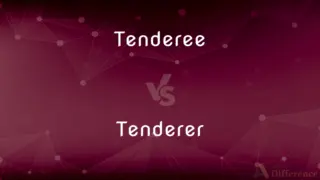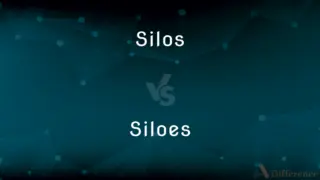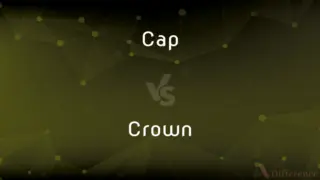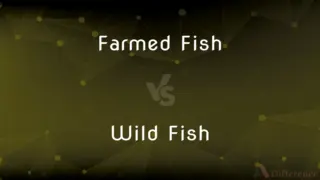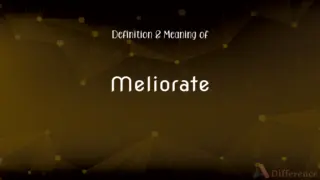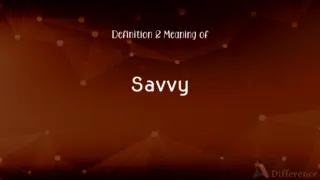Wool vs. Hair — What's the Difference?
By Tayyaba Rehman — Updated on November 5, 2023
Wool is the soft, curly fibers obtained from sheep and certain other animals; hair is the fine strands growing from the skin of beings.

Difference Between Wool and Hair
Table of Contents
ADVERTISEMENT
Key Differences
Wool is a natural fiber grown by sheep and is known for its crimped texture, which traps air and provides exceptional warmth. It is used primarily in the production of clothing and textiles due to its insulation properties. Hair, in contrast, is a keratinous filament growing from the epidermis of animals, including humans. It can vary greatly in texture, length, and color among different species and individuals.
The fibers that constitute wool are generally finer and have a natural elasticity that is not as prevalent in hair. Wool fibers can also have scales that cause them to interlock and form felt. Hair, depending on the species it comes from, may be coarser and less crimped than wool and is not as likely to felt. Human hair is often groomed and maintained as a part of personal appearance and hygiene, whereas wool is harvested and processed for textile production.
In terms of use, wool is specifically sheared from animals and then cleaned, spun, and dyed to create woolen products such as sweaters, carpets, and blankets. Hair, however, serves multiple purposes that extend beyond the textile industry, including providing thermal regulation, protection, and sensory functions for the body. People also style their hair for aesthetic or cultural reasons.
The qualities of wool, such as its ability to retain heat even when wet, make it a prized material for cold-weather garments. Hair's qualities vary significantly across species; human hair can indicate personal style, while an animal's hair can offer camouflage or signaling functions. Wool's value in the textile market is linked to its unique characteristics that are not replicated by other animal hairs.
Wool production is an agricultural industry that involves animal husbandry and land management, contributing to the economies of countries like Australia and New Zealand. On the other hand, hair care is a major component of the beauty and personal care industries, emphasizing the cultivation of personal image and style through products and services aimed at maintaining and styling hair.
ADVERTISEMENT
Comparison Chart
Source
Sheep and other specific animals
Humans and many animals
Texture
Often crimped and elastic
Can range from fine to coarse, generally straighter
Use
Primarily in textiles
Aesthetic, protection, sensory
Processing
Cleaned, spun, and dyed for production
Cut, styled, or sometimes used in wigs and extensions
Properties
Retains heat when wet, felts easily
Varies widely, may not retain heat or felt
Compare with Definitions
Wool
Wool, typically from sheep, is used extensively in the fashion industry.
The designer’s new line featured wool prominently in its winter collection.
Hair
Hair is the strand-like growth emanating from the skin of humans and animals.
Her hair shimmered in the sunlight.
Wool
Wool is a natural insulating material used in clothing and furnishings.
The wool rug added a cozy feel to the room.
Hair
Hair can signal many biological conditions, including health and hormonal status.
Her hair became fuller and glossier during pregnancy.
Wool
Wool is the fiber obtained from the fleece of sheep or other animals.
The sweater was made from the finest Merino wool.
Hair
Hair is a protein filament that grows from follicles found in the dermis. Hair is one of the defining characteristics of mammals.
Wool
Wool is the textile fibre obtained from sheep and other animals, including cashmere and mohair from goats, qiviut from muskoxen, hide and fur clothing from bison, angora from rabbits, and other types of wool from camelids.Wool consists of protein together with a small percentage of lipids. In this regard it is chemically quite distinct from the more dominant textile, cotton, which is mainly cellulose.
Hair
Any of the fine threadlike strands growing from the skin of humans, mammals, and some other animals
Thick black hairs on his huge arms
Coarse outer hairs overlie the thick underfur
Wool
The fine, soft curly or wavy hair forming the coat of a sheep, goat, or similar animal, especially when shorn and prepared for use in making cloth or yarn
Harris tweed is made from pure new wool
Hair
Hairs collectively, especially those growing on a person's head
Her shoulder-length fair hair
Wool
The dense, soft, often curly hair forming the coat of sheep and certain other mammals, such as the goat and alpaca, consisting of cylindrical strands of keratin covered by minute overlapping scales and much valued as a textile fiber.
Hair
A very small quantity or extent
His magic takes him a hair above the competition
Wool
Fabric or yarn made of this hair.
Hair
Any of the cylindrical, keratinized, often pigmented filaments characteristically growing from the epidermis of a mammal.
Wool
Hairy or downy material on a plant or animal, as on certain caterpillars.
Hair
A growth of such filaments, as that forming the coat of an animal or covering the scalp of a human.
Wool
Filamentous or fibrous material similar to the wool of a sheep or other mammal.
Hair
A filamentous projection or bristle similar to a hair, such as a seta of an arthropod or an epidermal process of a plant.
Wool
The hair of the sheep, llama and some other ruminants.
Hair
Fabric made from the hair of certain animals
A coat of alpaca hair.
Wool
A cloth or yarn made from the wool of sheep.
Hair
A minute distance or narrow margin
Won by a hair.
Wool
Anything with a texture like that of wool.
Hair
A precise or exact degree
Calibrated to a hair.
Wool
A fine fiber obtained from the leaves of certain trees, such as firs and pines.
Hair
(countable) A pigmented filament of keratin which grows from a follicle on the skin of humans and other mammals.
Wool
(obsolete) Short, thick hair, especially when crisped or curled.
Hair
(uncountable) The collection or mass of such growths growing from the skin of humans and animals, and forming a covering for a part of the head or for any part or the whole body.
In the western world, women usually have long hair while men usually have short hair.
Wool
Yarn, including that made from synthetic fibers.
Hair
A slender outgrowth from the chitinous cuticle of insects, spiders, crustaceans, and other invertebrates. Such hairs are totally unlike those of vertebrates in structure, composition, and mode of growth.
Wool
A resident of a satellite town outside Liverpool, such as St Helens or Warrington. See also Yonner.
Hair
A cellular outgrowth of the epidermis, consisting of one or of several cells, whether pointed, hooked, knobbed, or stellated.
Internal hairs occur in the flower stalk of the yellow frog lily (Nuphar).
Wool
The soft and curled, or crisped, species of hair which grows on sheep and some other animals, and which in fineness sometimes approaches to fur; - chiefly applied to the fleecy coat of the sheep, which constitutes a most essential material of clothing in all cold and temperate climates.
Hair
(countable) Any slender, flexible outgrowth, filament, or fiber growing or projecting from the surface of an object or organism.
Wool
Short, thick hair, especially when crisped or curled.
Wool of bat and tongue of dog.
Hair
A locking spring or other safety device in the lock of a rifle, etc., capable of being released by a slight pressure on a hair-trigger.
Wool
A sort of pubescence, or a clothing of dense, curling hairs on the surface of certain plants.
Hair
(obsolete) Haircloth; a hair shirt.
Wool
A fabric made from the hair of sheep
Hair
(countable) Any very small distance, or degree; a hairbreadth.
Just a little louder please—turn that knob a hair to the right.
Wool
Fiber sheared from animals (such as sheep) and twisted into yarn for weaving
Hair
Complexity; difficulty; the quality of being hairy.
Wool
Outer coat of especially sheep and yaks
Hair
(transitive) To remove the hair from.
Wool
Wool refers to the soft, curly hair that is spun into yarn for textiles.
She donated bags of raw wool to the local spinning guild.
Hair
(intransitive) To grow hair (where there was a bald spot).
Wool
Wool is a textile fiber renowned for its warmth and crimped quality.
Wool blankets are essential for camping in the mountains.
Hair
(transitive) To cause to have or bear hair; to provide with hair
Hair
To string the bow for a violin.
Hair
The collection or mass of filaments growing from the skin of an animal, and forming a covering for a part of the head or for any part or the whole of the body.
Hair
One the above-mentioned filaments, consisting, in vertebrate animals, of a long, tubular part which is free and flexible, and a bulbous root imbedded in the skin.
Then read he me how Sampson lost his hairs.
And draweth new delights with hoary hairs.
Hair
Hair (human or animal) used for various purposes; as, hair for stuffing cushions.
Hair
A slender outgrowth from the chitinous cuticle of insects, spiders, crustaceans, and other invertebrates. Such hairs are totally unlike those of vertebrates in structure, composition, and mode of growth.
Hair
An outgrowth of the epidermis, consisting of one or of several cells, whether pointed, hooked, knobbed, or stellated. Internal hairs occur in the flower stalk of the yellow frog lily (Nuphar).
Hair
A spring device used in a hair-trigger firearm.
Hair
A haircloth.
Hair
Any very small distance, or degree; a hairbreadth.
Hair
Dense growth of hairs covering the body or parts of it (as on the human head); helps prevent heat loss;
He combed his hair
Hair
A very small distance or space;
They escaped by a hair's-breadth
They lost the election by a whisker
Hair
Filamentous hairlike growth on a plant;
Peach fuzz
Hair
Any of the cylindrical filaments characteristically growing from the epidermis of a mammal;
There is a hair in my soup
Hair
Cloth woven from horsehair or camelhair; used for upholstery or stiffening in garments
Hair
A filamentous projection or process on an organism
Hair
Hair refers to the keratinous filaments that cover the scalp of humans.
He had his hair cut short for the summer heat.
Hair
Hair is often a defining characteristic of mammals, varying greatly across species.
The biologist studied the different textures of hair in mammalian species.
Hair
Hair is commonly styled in various ways as part of personal grooming.
He used gel to style his hair into spikes.
Common Curiosities
What animals produce wool?
Sheep, goats, alpacas, and llamas are common wool-producing animals.
Is hair alive?
The hair shaft is not alive, but the follicle from which it grows is a living part of the skin.
Can wool be dyed?
Yes, wool can be dyed a variety of colors.
Are wool fibers always curly?
Most wool fibers have some degree of crimp, but the amount varies among sheep breeds.
Can hair be used to make textiles like wool?
While hair can be used, it is less common due to different textures and properties.
Is wool hypoallergenic?
Wool is considered hypoallergenic but may irritate sensitive skin due to its fibers.
What is hair primarily made of?
Hair is primarily composed of the protein keratin.
How often does wool need to be harvested?
Sheep wool is typically sheared annually.
Do all mammals have hair?
All mammals have some form of hair, though it can be very minimal in some species like whales.
Can both wool and hair be considered renewable resources?
Yes, as both regrow after being cut, they are renewable resources.
Does hair serve a purpose for humans?
Yes, it provides thermal regulation, protection, and has aesthetic significance.
Can wool cause allergies?
Some people are allergic to lanolin, an oil found in wool, or may be irritated by coarse fibers.
What is the main use of human hair?
Human hair is mainly for personal styling and appearance, though it can be used in wigs and hairpieces.
Is all wool the same?
No, wool quality varies based on the breed of animal and processing methods.
What determines hair color?
Hair color is determined by the type and amount of melanin, a pigment produced by cells in the hair follicle.
Share Your Discovery

Previous Comparison
Pastor vs. Apostle
Next Comparison
Velvet vs. FleeceAuthor Spotlight
Written by
Tayyaba RehmanTayyaba Rehman is a distinguished writer, currently serving as a primary contributor to askdifference.com. As a researcher in semantics and etymology, Tayyaba's passion for the complexity of languages and their distinctions has found a perfect home on the platform. Tayyaba delves into the intricacies of language, distinguishing between commonly confused words and phrases, thereby providing clarity for readers worldwide.











